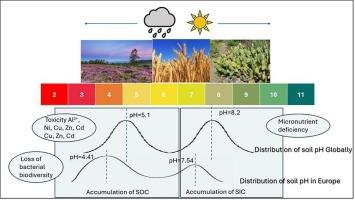全欧洲土壤pH值与土壤健康和退化有关的模式和阈值
IF 5.7
1区 农林科学
Q1 GEOSCIENCES, MULTIDISCIPLINARY
引用次数: 0
摘要
土壤pH值表示土壤环境的酸度或碱度,影响各种生物地球化学和物理过程。此外,土壤pH值对于确定铁、铝和重金属等有害元素的生物可利用性至关重要。因此,pH值是土壤健康和退化的重要指标。虽然对局部水平的土壤pH值已经有了很好的认识,但其时空变化以及国家和大陆尺度上的重要阈值并没有得到充分的记录。在这里,我们分析了欧洲表层土壤pH值数据(LUCAS),并结合LUCAS调查中的其他土壤特性,以确定与土壤健康和退化相关的欧洲土壤pH值的阈值和空间格局。在欧洲尺度上,我们发现:1)以年平均降水量减去潜在蒸散量(MAP-PET)计算的水分平衡为解释土壤pH值提供了必要的背景;②pH约为7.2时,有机碳富集土壤向无机碳为主的土壤转变,但土壤水分水平可能比pH对土壤有机碳积累更为关键;3)我们在多元回归树中发现了三个不同的集群:嗜酸菌(pH值低于5.2)、中性粒细胞(pH值5.2 - 6.9)和亲碱菌(pH值高于6.9),而最佳微生物多样性发生在pH值6 - 7之间。根据sWorm数据库的报告,蚯蚓的丰度更加微妙,并且依赖于土地使用;4)重金属降解的风险不能被单一的pH值所捕获。最后,我们确定了土壤pH值阈值,可以帮助决策者确定可能需要保护或干预的区域。本文章由计算机程序翻译,如有差异,请以英文原文为准。

Patterns and thresholds for soil pH across Europe in relation to soil health and degradation
Soil pH indicates the level of acidity or alkalinity in the soil environment, influencing various biogeochemical and physical processes. Additionally, soil pH levels are crucial in determining the bioavailability of elements such as iron, aluminium, and heavy metals which can be harmful. As such, pH is an important soil health and degradation indicator. Although there is a well-established understanding of soil pH at localized levels, the spatial and temporal variations, as well as significant thresholds at national and continental scales, are not sufficiently documented. Here we analyse the European topsoil pH data (LUCAS) in combination with other soil properties from the LUCAS survey, to identify thresholds and spatial patterns of soil pH across Europe in relation to soil health and degradation. At the European scale we found: 1) the water balance, calculated as mean annual precipitation minus potential evapotranspiration (MAP-PET), provides essential context to interpret soil pH; 2) the shift from organic carbon-rich soils to those dominated by inorganic carbon is observed at a pH of about 7.2, however, soil moisture levels may be more critical than pH for the accumulation of soil organic carbon; 3) we identified three distinct clusters within the multivariate regression tree: acidophiles (below pH 5.2), neutrophiles (pH 5.2–6.9) and alkaliphiles (above pH 6.9), while optimum microbial diversity occurred between pH 6 and 7. Earthworm abundance, as reported by the sWorm database, is more nuanced and dependent on land use; 4) risk of degradation by heavy metals cannot be captured by a single pH threshold. Finally, we identify soil pH thresholds that can aid policymakers in identifying regions that may require protection or intervention.
求助全文
通过发布文献求助,成功后即可免费获取论文全文。
去求助
来源期刊

Catena
环境科学-地球科学综合
CiteScore
10.50
自引率
9.70%
发文量
816
审稿时长
54 days
期刊介绍:
Catena publishes papers describing original field and laboratory investigations and reviews on geoecology and landscape evolution with emphasis on interdisciplinary aspects of soil science, hydrology and geomorphology. It aims to disseminate new knowledge and foster better understanding of the physical environment, of evolutionary sequences that have resulted in past and current landscapes, and of the natural processes that are likely to determine the fate of our terrestrial environment.
Papers within any one of the above topics are welcome provided they are of sufficiently wide interest and relevance.
 求助内容:
求助内容: 应助结果提醒方式:
应助结果提醒方式:


